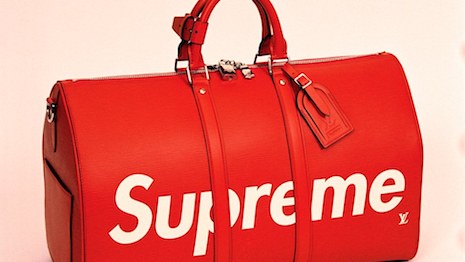Luxury shoppers are increasingly turning towards more casual styles for self-expression, according to a new report from the Boston Consulting Group and Altagamma.
Millennials are expected to represent half of the luxury market by 2024, and their fashion choices differ from previous generations, as they are more apt to mix high and low labels as they seek out clothing that fits their personal brand. Traditional luxury brands are responding through adaptation and collaboration.
“Collaboration covers demand for newness in a less risky way," said Olivier Abtan, a partner in BCG’s Paris office and the global leader of the firm’s luxury, fashion and beauty topic. "It gives brands a cool edge and strengthens brand awareness as well as increases willingness to buy the brand.
"Collaboration is increasingly in demand and turns out to be a very effective purchasing incentive,” he said.
The fifth annual edition of BCG and Altagamma’s True-Luxury Global Consumer Insight is based on responses from 12,000 luxury consumers from 10 countries.
Growth drivers
BCG and Altagamma’s report projects that the luxury market will grow from its current 915 billion euros, or about about $1.1 trillion, to 1.26 trillion euros, or $1.55 trillion by 2024.
Millennials and Chinese consumers will be the driving force behind much of this growth.
Both of these demographics are digitally savvy, calling for greater investment in omnichannel strategies.
Overall, 55 percent of luxury shoppers buy via mobile commerce. Among China’s youngest consumers, about three-quarters use their mobile devices for shopping.

Digital has been cannibalizing in-store sales. Image credit: Value Retail
The report also found that social media has now become the top channel of information for luxury consumers, surpassing magazines and brand Web sites. Among the most powerful platforms are Facebook, Instagram, WeChat, Weibo and QQ, however QQ is losing some favor to WeChat and Weibo and Instagram is becoming a more dominant force than Facebook.
About half of Chinese consumers turn to social media for research, with word-of-mouth the second most popular source of information, as 30 percent look for insights from friends and family.
Casual clothes
The number of luxury customers who prefer more casual wardrobes has grown 7 points in the past year.
One of the trends driving this shift is the rise of streetwear. Through brands such as Vetements, the hoodie has been elevated to luxury status.
Responding to this growing preference for casual attire, a number of brands have launched collaborations with streetwear labels, including Louis Vuitton’s co-branded Supreme capsule and Jimmy Choo’s Off-White footwear.

Louis Vuitton co-branded pieces with Supreme. Image credit: Louis Vuitton
Through these one-off lines, luxury brands are able to attain a sense of newness without losing their more traditional branding and positioning.
Whereas earlier generations were more apt to seek out fully luxury wardrobes, millennials are more apt to trade up and down to achieve their desired look, with 55 percent mixing and matching price points. For instance, this may mean luxury footwear paired with more affordable attire.
However, even as they curate their wardrobes to fit their personal style, millennials are also the most brand loyal of all generations studied. When they decide to opt for a different label, it is often because their favorite brand does not carry something they desire.
Due to their differing consumer behavior, millennials may also require different retail tactics.
For instance, ecommerce platform Spring is appealing to the millennial shopper through a new program that gives customers cash back in lieu of points or promotions.
SpringBack is positioned as an alternative to the traditional loyalty program, as it rewards customers for every dollar spent with Spring with cash back rather than store credit or other brand-specific perks. Retail has typically looked to periodic sales to drive business from value-conscious consumers, but Spring is aiming to win with consistency (see story).
{"ct":"9J1Sh+owNkpaovWd+soPMgTZD2lwVuHzt6aLXuhnYODIDK6yL5iR2v7UUIAIDO7LuEQAZXRA4snvKDqtPab2lchKQHNBttnB1lvf\/RN6NiWCzLvEnVbrDZbsi2ec0cUvpepmupFA+ljCnJ4UrIAA8L7FdJ5\/NM3\/sY0w2nS8PhG3FourwBrD6bDZC32W2WSAhbqyKY\/80zqS5fjBYyteD3igDK4eym3M4HUPVq6lUW7rmLhqTgg1uUJQR5Yithg7aUZYleK6UEtDid1AeBJkIPWU+8no2g6JL9lEqpc18Ed3GLNuas33SKWGuTI2oXix00gkc4EGgdnqSfZSltX0VUlaEd96Zmqr9Jd22aPlZRVw\/rG5OOz6HDtlgUjArFlXQYicdiHtFpss5Rn78xHuiQ6MnZ2JcNisb1qq0GHb3WMEfLKOKWOaAGdg7C\/lAUawAOG2WOMg8gSZQ3UjJBYirObAXQjKcemmVkuXetIiL1MYTFOIxXe0kl+DqZW6XVImApdCnSCOXT1lQ+7dDh7LmmzdGq83ZeEnbnCUJMlGRE8raFfgatrZHNzjLVS7BYOOsZFT78VqSRKnS2oRl1KnZjWPO5b0XM10XTU\/+HZ5Bwe+Ruk4fDNhMIImP7obkr0GleA+WUnQ8L4w7VjlD2+Pjs5rJhAD7AeGhmiwr4NEXXltZfLSDX6fhMkToPAxBukyutxhx0UhF2zuAu3Jt9xjmQZYPxyv8+YPbaVPvWZIbz2BBZXHYhApxBxYMKUDaU3j\/0PbBtv8Vfq+Zob0kgw+rFTnnr3J3Y6wSp9AMF5joHMSuS4Y83qnkgs7GnQc\/AWbiRvCBtPg6opoMV9aGwk3hlvgny6NGaHVwf+5J1+GwtOOkcsbDDll+YULwVzmkxR29I3x5eLkk3rzQzAq9eLSoSW\/zWrzlhjSa7+ExJ3\/XLaP8NFfVmNfSgTz2bdNqyMF6VYC0GaPmMlStFLgTZ8q6i\/OozJYfJhu6kD\/Haru4G2bHSuu+xyD\/syLt\/5jaYT7xnFkPHR4qg6X4ugJAypubxCnSqFaZezN\/rZCoJ1hS68\/1NWRRJaugMsTDYkh+iIuF9jU9MK2NXo8PSp14szcdRuMvvn+CY98VXFHWrZ865RK+h46lWpgsntQzi0AFPvPc6vW8jWnim0rF\/KrrtVZ5bwKRp8aNRwH6kNFcr+O\/dmHQw2kTBsWbAD1DbwHcrwEn3kYBhg0HYGGCNyi56JvLUX04fWXSKfV5ero9SJzBtR9snNu2Ul31yYS\/JU1QY1BPK81LO8cjJ4V4qd3PWkLy+xNYVeSPhLX0eajiQNejlC5xCvVw2zrXVYv0b5FHiTM\/137+qHz4RmeWzvWgHesJFcPmKeFl7n4cIcX1aS0YQMub08kE5IhMHpSsDoWOsUBfH3QRgqfZ0DXUsGYbcP5Q9wtpGwcIgddvQfCf15pq9JaUMc3tr8cdVTmW6cw15619j5\/axxHY59hAjzokLsKbGyovVc7mX6PpLD+iuZMDqsgj1UgKmzZ5ld2g3fk3smM62TrLMeNNqQWiAZ2vJRdVbYYnYRs3bn\/UzBkCpDJGmU6CgIPCMYxJ1AYyZn\/6kC3dUVtZGzfD84p5ef9E30BZcWDXKS706Q2ClIch0N1uN9wrnSOLUF25Re\/ZhJe\/QTpT1PCfXEhFyZso8RU3AckGSeJ1NtqP+zMf56Mq4L+Gq2lHaGbVOd8am0Rv99okaLPwasBybSSTe4sFDA4VI5cHW53EWCwXNzlJOp6vlBTQ4dSZdUdFDM664gBhUPCkJXZdliW80g\/W+ibcoyqIR5j\/suFg+5UatGKAoT2YHRM39iUW+0XbD7iGzqjOr+FlM9UnLF76qH7z+V5MjWz7nawpCxcVo\/aPcv2apX4rmPO8rWe5cMJtz81vUok0Ix6tsIZEQYBcgPaUkM1eIz46nwIwmpr9JfvjgyLDE9rI+1yaCsEA+CHK3uVpBqpSMBF80Q0rzty7FaerSWq0obhgfEChekYg38xGWRYdsCypFo41Le4gtnxERcmBdzwgDJOA7HKdt\/++M2+WZ7OHJ6bJPhuwPHnS+LGoP7ZokD0PyWkvLhC1eM2knTrFsmHRR7nuyvgUg4VCYkfp+6Rt1NtggoutvmUTGXV5SNWxm\/DVhFNBzgPlJ8cCiIlwH9X8roZJy3JER21OsNsJvNSCbrSH3upbF0rP4dFZzDETO85mPCezeIAdC8CwZMU7cuU0dc0wOje12+LG6Xl+pe55K38nVjUh2aVTXoHb0FfJcfkdjLVXj7DE8PvwBAZ7d452TY41gG96b8+HJZ6nDRcPzW8kiz8I6X6J5RDeBwVkC28HGw4plicnpBPha6Ye7WwXVHef+YjgNY\/pyKfCy6QCa4SJUkD9dV\/LXRTZ7nW+c0WY+BdhesJyYmn62t4OYnuRIrik9BSOeyTjPaLfd\/1\/DLdFHsiSYVG+Zd75hcyEoZaZaBkpbMJIS6B5oNzC1A7Uv\/vwH7ILFwoU6yKcD\/Ip5Pli+eboYHeU\/B1I4jv8mDh8i+PSl6OR62qGz6ivCrCj\/ohQU2TAn4ZzYH2QK\/uCdIGhsKI2D97kVQsVH1rUor73Ij9CYcHYUve6TvLWV1pEQK4RBah3NIdwat6zamCI8mGxu4\/H6biSrxZT2gh8uBqeIhZ3MY3chRAQj8icamH+9KAeACtxHvPdKThKlDjt4z8iDs3VLX8TRVsh8M+LzDOuT\/HTp9xnWwnSeCV+yySW5IqcNvf3qLuxSDkwntW0utMnaMbUWkwVCoN5\/ZUpJ6IJBnXHACerBkczLrQNZoC\/2N5klbd2h+lgtS5EuuZuSiZgw608Iv14fFy5Ic3vu6yIrrRknTRZcllsPQ5FDP9T2Csx2WiSK2wliLqmAh7buVamPdIKGCO2Z95f2M+dCODxkupQ9rkbgAm7W+Uuwn7WdeJjzomgZ7DOnIA\/fFc6LbHcRxrMVp\/XC\/3R3kz5Zz8VGk+XkV6yf\/0ODmHBZCQqqCK07X+QcA6q7HzMaX\/WMBbZFc3q1tq5vGdyr9AdZHxZy30VJXCXRXbigl60RqjFqRnfGlwaBfo9RE3\/CQrUpkY3XF4FhUVDDjiwRXvk\/RJNw5ZJVndxoQsp+acMV181JeFcmHDfuEUt6QnCIz+HhxSMNZQdbvPAVef1tAayTJYDQ6Y\/2rsERbpVAuodg0tND7xXxgSxh60h078jMGp6xfk4\/7USyRSwf4FsdKLk2WGAaCBDEHkNyhpxwt3K4WvrjuGtw4L0WFO4YeFdJrCUueveS0drxUQymhuzbxjkaWncKpy\/+EmxRBOPetzmquFHAU4JRYP\/juKX6hCJDeySqvSOGJuV3rRdSjUkJBZN\/7s0fzZsg6\/mR7c4IgMBmt5Yk0bwunJEFHQe3tCmhff2i1OHn1MRGZqtUGJalXE+tONhDhCjLc\/N1iCMY980M3iRwv25OoodKUInpVZzJabTa7BteIsRM2kBQXL0hBvG\/2r89HXoZDaeP2iqJDoMXGwTwTewPB7pjsF7xu42jy2LEtmzSbDKALYIqsDCVwEjtsxQEdllp7SLb7dh9+3VV2TepAh5XprQH46hxcNzdUmdO697umMfOJ+RHaxVwRgRFXD\/StjmTQUUMMkoCbmVur2PkxmlNqTmoLS\/nO5\/PJG+BMGMEq54smBnsIJnGvCHiUZID\/AzLlm2Tb\/MTMi0fTcDk3ASxJHBfdUbv5vTjo7uPcLVpa77iuNPrg8rtaHYgKasyzmmWlbZBlVvAJR7U5RCp7g2fpLDSDwoFjKMRHoojYTZrIGz5yfFGsVTHdt89ZeIeppuRuFHTJsiZzAYNSk92Z0lXDDaW\/iZrr8h1QoGBMUho49f1DnbeO69WHSn1060ejTxAY98nMiz4z1YO6JRo7OwjNxh9fHGnyCi5qGMgqjVC9+w\/oSg33pmuOzL5wIQKs99Q0ZVCH2JMQG9o8oxTPZEQHLoOozWZ9DMBtSc2ofnhqbr4wdkFUtjUcf4cQaNihvLXU2TwV8eLXwtLeV8QLVxZnIGrdjq41t1iOCzDdMb+QOL+QW7Yhv+RYnd+k+Ro5ucAeHqVV+BESggHYfn330pQwIQg0UBF+J+DAVQD0qeaqJzLGTUEeP6WgkHSd+FM+PkzpmHmunbwxRgJRdMSMbaWI\/oV8UdASDeABZzbwqJapey5LjB08F3Yx7Eil3ALuEoaeswP1UZaiwbd0Ij5SSXZLBcM9o6Rtxr8OS6UWaTI7GpBt2Scvw2PgOLEQW6jIV1XwPUdiuQCingwQ4UaEFQZN+AsUgxGHTF+Embyqb96n3HuOmjCTyrlSbMJNoW7bf2++8X\/joXdNGzYDT5Ks6EOxkfEyS96Kg4gBjQusO+wSLi\/IJbJYcasf0qYnlfBeX+6F9SF9adxuv+7s1ZpkbhY3NtlwsJH54\/Nl00enoPoos7sZsAnp1\/Q1nDB5VJiN14s0jRDwC14wnZ+BI\/8IZo3eLIYmv1GEAGDTA8j0AOXT2crK8sS0\/AGw+BQ6MvkkPrwZhYmudV5mdaiJzgcvQ5IDRaCF49JZ\/noOSY9sCwPpGNGdITBdKhUkJilBSez5DNrOyvJFetUw1qbYXLWOusVKh6sXRnQAnw64eH0BmDp+71Knqjc\/93OmAcLH7gzBpdoNp2PJx7QkVpZ3nGOl22wMjGw\/9WNLzazPuY16h9z05vg1CZOC2u9aEONLRrqx9ywLiK6vjn4\/E\/R0BOCwZi5TU89y\/c8lnjpxWvdwrtqI4tmTyynHQfTMMSRdZd96BXMTyfCQ9PFYBf01sdw63IMpg2MzCtJAMWCiKpgq2iM7TWU2ysoWc3ZCoWoWAbBezSYrqBtx39QP2H+YFXHPVcZbTzKH6pzwAtUk6nnWLzT0aIsAbV0pvD3nxt5GE0i66gajETkHPWTwSqQNgz4YXZ8ghVg+pBP8I\/EHfiZvIgyerkCmaFfUDtUPy2mOcKi0LnpGeCaRsw9JC\/VZQJ+vm\/X0FEVwpuhEtDfmKqjVQHCttJgK+wtaENUhoi7kvj6LeA7nPd1RUs2EUNeEEwMTglXI0\/AuyixsUboYAE5elZ2RPQQUPlxzsbo8eif74SbdT8XmMwqi\/ERdnVkKKx5JMsOKReFfqmPfkNAraFt4vHphDkqq\/nNu\/YhQC8XMbBWH\/nIGtHzQbvsS5uH4b5kkdK2GXeEn1vsoxCxUkKWtX5ZcrB8LOWzVgvTatK0MP+sjBd6hHl893tQXT1Rsz5OSRrz23lk9geoyr1p1Op8eWMAOfGI3gwIccjr5DdPXmAfPWPXBmfhISaVi\/P1qaY\/N5WMUosWUYSdE+6lb+rxrs0obklJK99D45JP9WCC0JZg\/dp3+X8tPbOpEaDwUTMHubIEAwHbs7cdJUltNYHE8OCnzOXJUoH5fwfhDLQFUSrgN\/T2TQbGswjsTmACo9e4Z3WOsUKhDE5\/v\/10ibLWLLN24pE9m9H8HF9om8EEElz4f4bO+cBTRbJPQDtvkvv373vp0ALh3gxMnZJs6Kd85uZVpwm8LM6F6cgYUVzBGJep8E0Euwn9\/7667jQeQOWVL6ib9gnSv3cF8ZyYvBmljtqH+rD+SRTx\/KCEuQVDnwKDBJ6FI1yZLTri3ev1fIzJXbB3mwLkk5t1jJaWgQlSVc33MeF8T0DJTUBtVIht19me74xb45m89yJquypqEL7eSnsn9I2PMCT\/5Zz8YhvbniITxVOJ8feBg4KRYW6F+Jll0+AWLhWnT\/PVbryHdgwNg8PnUv3YvdKDG731KTEZ4V2nJCc+w5099U3FmgujSBxb6me5jjhk4FIdmqxolGewtHbE99cefn0hV8\/lPoaPzh7lAkp\/rrTsJ0qnH1WKCnpaoQ6V8pqspX0gBwLnO\/+Ub0J+cMSoMnWnh6K6JTd8Ev9hrprBNi2cTLcABH0uPPHJs7\/wxN5tMNk93Wp\/KgEWGIwZWkFQI4NRS5FozYh5NJffXpI8xKK8qFoldgGXv5hSbZihoIujozoU+s0yGe0hdG1CcWc8kWMbXex705Uluq0UflbLc4niGDWg1Xv2Q9JPsr7cK1ueRmUXTud3oFpnM53Np+iyUGSZj2cCTfEnEGnmpiSTT\/xYAbIf6SbI+wEOOJEDcssEeTLUMNlDVIRYQUdzW8NVRxGsWSeX\/d4LqG\/jqkVQjpm4BLDGBRgSBlfqt01t6+vhZxH\/b\/h4bhZkhl6hn468XoMnJbAdAEqtro7XlKaQqe+IJMppKFdCYGxwProsrn2039hAhXaVkTOg5u3iUvUz6KGijdvu\/sXv2Y7umWEoCtYHzIwI7PkXd9SyowbF40fgwrgl1QW4LCTRb8lReZ5Saq+bIm9cX0VLiRk4DALMVcAfvdZw\/76c\/is8BmOWhAp5qmPyOYp6tPG\/iHl5aY9FqV\/i+PI3DTWUsAwZGwYse+DJDNvRj\/E7kfWoU7fOZxQK5YHFrAAEu+rHzliGMl0JBQX4IQKqRrT3d3Zbb7yM2DCAO1MpmO8x4NLLR7LRhA7XuvLm86Ht33r0KrHBro3fMuxuPHDWw\/AMkDFdpcfowaBNuqHk3I9t8wSHZt5YUNe93J6XJgwntNA6+7zwJ65R6BguRtAxID3DxIOwDQK7fO4bEPk6BNjop\/+x9j5wVS7+lFa5\/uXMlw2qZVlEWB9gVa17Ww15fR+kfre2\/+mF8PhYyw0nr2wHUUtWNY5UUIfK\/OahndZEiHD9t60XGU44CoOak94YnJwiBNZkKbBxFSlJQjH3p7axD6NKndOuUl8GoTEc+m2bw9fKor+PXgY9q\/vXu1ElTsrYKV1ScAy4WARy9dlo+bHAlG+ui56K2Fd32rUlaPNq4WCFkxlauzpq+C2Twfz0ozAv7g6pVVkw4VkhdKJuMFc7fQBDOvdfeivzucS2p1Y2qm7SwXHhdoKnPfCrPJauzdd7iY7Dvc6Hw722gaRT86RAHwEGj0OqUUw6AGieFgOsdFCed1GNueNUccMIiMsvj1ClrZ+KTTg5uhPE5Wwzep01xqxKMdSgqTAqcBTlGa0fMnYrtosj1a9r+bGPwSeXEs1uAhPEsYeA==","iv":"bb7268b9215e2bce35d40489b91ff4c9","s":"1a456b3e15c63f45"}

 Jimmy Choo x Off-White is just one of the recent luxury streetwear collaborations. Image credit: Jimmy Choo
Jimmy Choo x Off-White is just one of the recent luxury streetwear collaborations. Image credit: Jimmy Choo